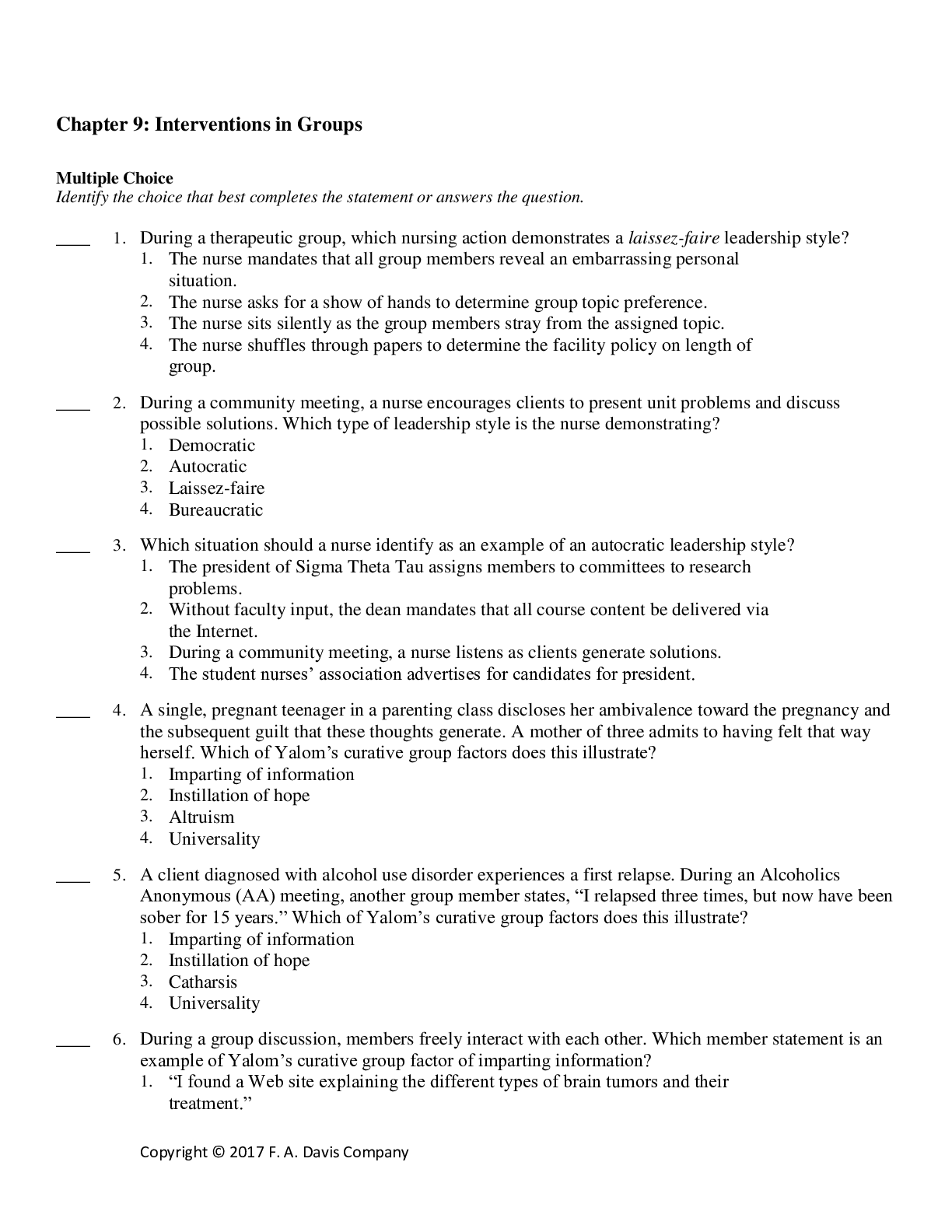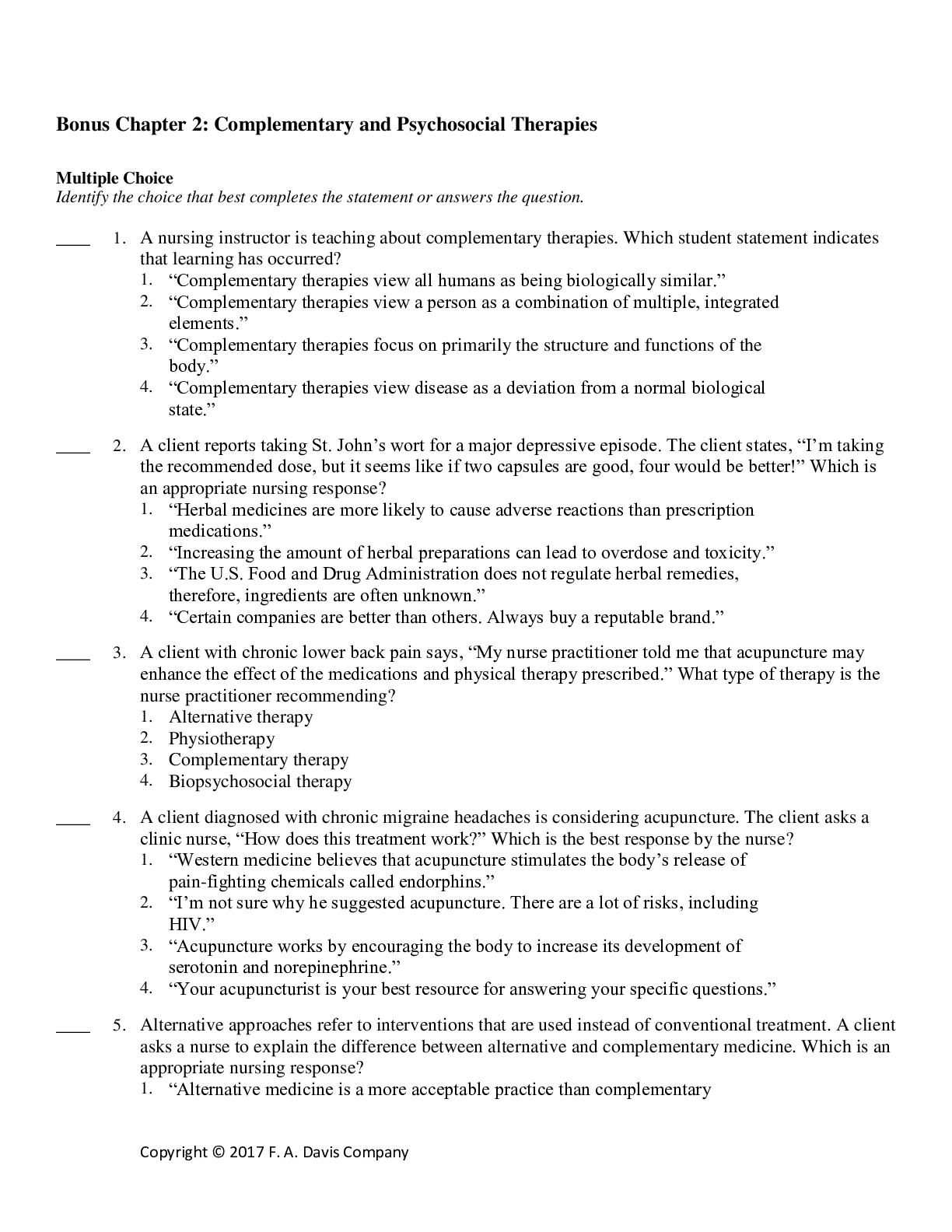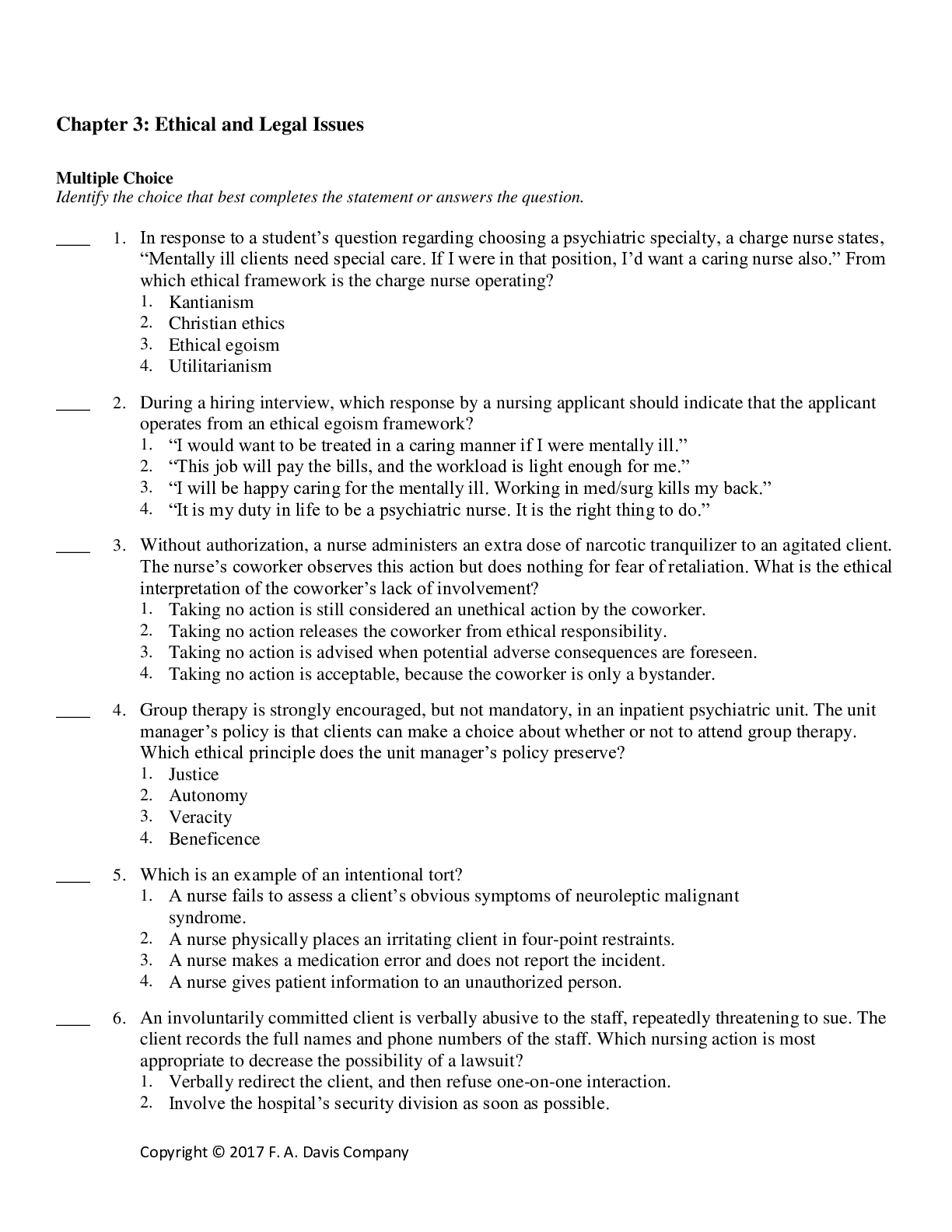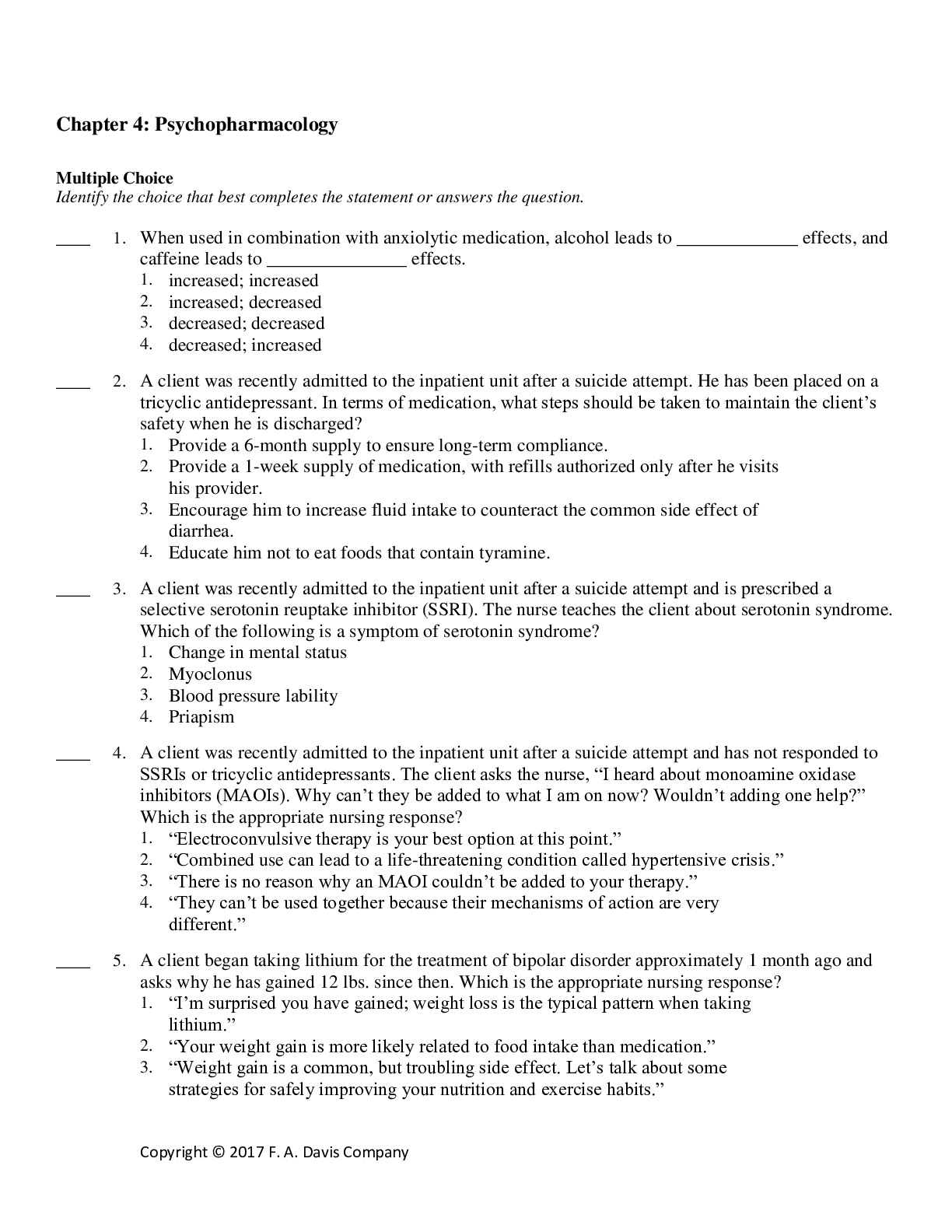*NURSING > QUESTIONS & ANSWERS > Chapter 9: Interventions in Groups. With Answers Explained (All)
Chapter 9: Interventions in Groups. With Answers Explained
Document Content and Description Below
Multiple Choice Identify the choice that best completes the statement or answers the question. ____ 1. During a therapeutic group, which nursing action demonstrates a laissez-faire leadership styl... e? 1. The nurse mandates that all group members reveal an embarrassing personal situation. 2. The nurse asks for a show of hands to determine group topic preference. 3. The nurse sits silently as the group members stray from the assigned topic. 4. The nurse shuffles through papers to determine the facility policy on length of group. ____ 2. During a community meeting, a nurse encourages clients to present unit problems and discuss possible solutions. Which type of leadership style is the nurse demonstrating? 1. Democratic 2. Autocratic 3. Laissez-faire 4. Bureaucratic ____ 3. Which situation should a nurse identify as an example of an autocratic leadership style? 1. The president of Sigma Theta Tau assigns members to committees to research problems. 2. Without faculty input, the dean mandates that all course content be delivered via the Internet. 3. During a community meeting, a nurse listens as clients generate solutions. 4. The student nurses’ association advertises for candidates for president. ____ 4. A single, pregnant teenager in a parenting class discloses her ambivalence toward the pregnancy and the subsequent guilt that these thoughts generate. A mother of three admits to having felt that way herself. Which of Yalom’s curative group factors does this illustrate? 1. Imparting of information 2. Instillation of hope 3. Altruism 4. Universality ____ 5. A client diagnosed with alcohol use disorder experiences a first relapse. During an Alcoholics Anonymous (AA) meeting, another group member states, “I relapsed three times, but now have been sober for 15 years.” Which of Yalom’s curative group factors does this illustrate? 1. Imparting of information 2. Instillation of hope 3. Catharsis 4. Universality ____ 6. During a group discussion, members freely interact with each other. Which member statement is an example of Yalom’s curative group factor of imparting information? 1. “I found a Web site explaining the different types of brain tumors and their treatment.” 2. “My brother also had a brain tumor and now is completely cured.” 3. “I understand your fear and will be by your side during this time.” 4. “My mother was also diagnosed with cancer of the brain.” ____ 7. Prayer group members at a local Baptist church are meeting with a poor, homeless family whom they are supporting. Which member statement is an example of Yalom’s curative group factor of altruism? 1. “Social services might be able to help you find a job.” 2. “The last time we helped a family, they got back on their feet and prospered.” 3. “I can give you all of my baby clothes for your little one.” 4. “I can appreciate your situation. I had to declare bankruptcy last year.” ____ 8. During an inpatient educational group, a client shouts out, “This information is worthless. Nothing you have said can help me.” These statements indicate to a nurse leader that the client is assuming which group role? 1. The group role of aggressor 2. The group role of initiator 3. The group role of gatekeeper 4. The group role of blocker ____ 9. During a group session, which client statement demonstrates that the group has progressed to the middle, or working, phase of group development? 1. “It’s hard for me to tell my story when I’m not sure about the reactions of others.” 2. “I think Joe’s Antabuse suggestion is a good one and might work for me.” 3. “My situation is very complex, and I need professional, not peer, advice.” 4. “I am really upset that you expect me to solve my own problems.” ____ 10. Which group leader activity should a nurse identify as being most effective in the final, or termination, phase of group development? 1. The group leader establishes the rules that will govern the group after discharge. 2. The group leader encourages members to rely on each other for problem solving. 3. The group leader presents and discusses the concept of group termination. 4. The group leader helps the members to process feelings of loss. ____ 11. A nursing instructor is teaching students about self-help groups like AA. Which student statement indicates that learning has occurred? 1. “There is little research to support AA’s effectiveness.” 2. “Self-help groups used to be the treatment of choice, but their popularity is waning.” 3. “These groups have no external regulation, so clients need to be cautious.” 4. “Members themselves run the group, with leadership usually rotating among the members.” ____ 12. When planning group therapy, a nurse should identify which configuration as most optimal for a therapeutic group? 1. Open-ended membership; circle of chairs; group size of 5 to 10 members 2. Open-ended membership; chairs around a table; group size of 10 to 15 members 3. Closed membership; circle of chairs; group size of 5 to 10 members 4. Closed membership; chairs around a table; group size of 10 to 15 members ____ 13. During the sixth week of a 10-week parenting skills group, a nurse observes as several members get into a heated dispute about spanking. As a group, they decide to create a pros-and-cons poster on the use of physical discipline. At this time, what is the role of the group leader? 1. The leader should referee the debate. 2. The leader should adamantly oppose physical disciplining measures. 3. The leader should redirect the group to a less controversial topic. 4. The leader should positively reinforce the behavior of collective problem solving. ____ 14. A 10-week, prenuptial counseling group composed of five couples is terminating. At the last group meeting, a nurse notices that the two most faithful and participative couples are absent. When considering concepts of group development, what might explain this behavior? 1. They are experiencing problems with termination, leading to feelings of abandonment. 2. They did not think any new material would be covered at the last session. 3. They were angry with the leader for not extending the length of the group. 4. They were bored with the material covered in the group. ____ 15. An experienced psychiatric registered nurse has taken a new position leading groups in a day treatment program. Which group is this nurse most qualified to lead? 1. A psychodrama group 2. A psychotherapy group 3. A parenting group 4. A family therapy group ____ 16. A nursing instructor is teaching about psychodrama, a specialized type of therapeutic group. Which student statement indicates that further teaching is necessary? 1. “Psychodrama provides a safe setting in which to discuss painful issues.” 2. “In psychodrama, the client is the antagonist.” 3. “In psychodrama, the client observes actor interactions from the audience.” 4. “Psychodrama facilitates resolution of interpersonal conflicts.” Multiple Response Identify one or more choices that best complete the statement or answer the question. ____ 17. Which of the following behavioral skills should a nurse implement when leading a group that is functioning in the orientation phase of group development? (Select all that apply.) 1. Encourage members to provide feedback to each other about individual progress. 2. Ensure that group rules do not interfere with goal fulfillment. 3. Work with group members to establish rules that will govern the group. 4. Emphasize the need for and importance of confidentiality within the group. 5. Help the leader to resolve conflicts and foster cohesiveness within the group. Other 18. Order the following leadership expectations that occur in the three phases of the group development process. _____The leader encourages members to provide feedback to each other about individual progress and to review goals and discuss outcomes. _____The leader promotes an environment of trust and ensures that rules established by the group do not interfere with fulfillment of the goals. _____The leader helps to resolve conflict and fosters cohesiveness, while ensuring that members do not deviate from the intended task. Completion Complete each statement. 19. A ______________________ is a collection of individuals whose association is founded on shared commonalities of interest, values, norms, or purpose. [Show More]
Last updated: 1 year ago
Preview 1 out of 14 pages
Instant download

Buy this document to get the full access instantly
Instant Download Access after purchase
Add to cartInstant download
Reviews( 0 )
Document information
Connected school, study & course
About the document
Uploaded On
Jan 27, 2020
Number of pages
14
Written in
Additional information
This document has been written for:
Uploaded
Jan 27, 2020
Downloads
0
Views
54


























